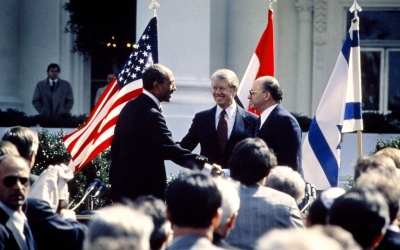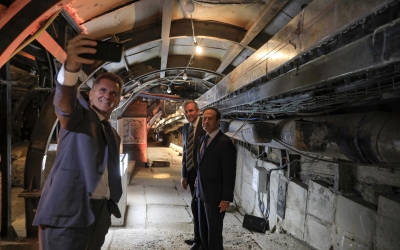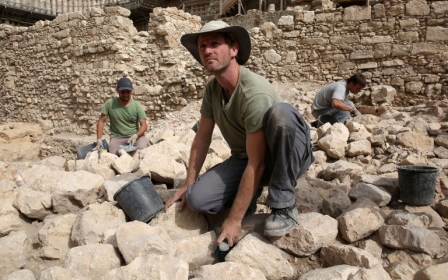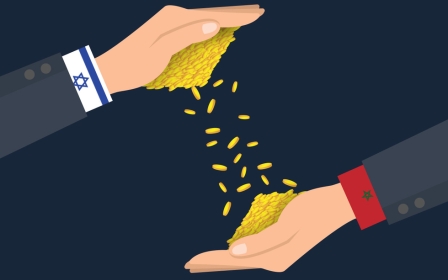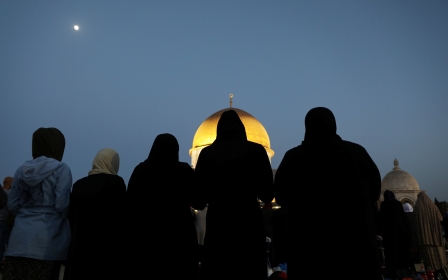The Moroccans of Jerusalem shocked by Rabat normalisation with Israel

Many Palestinians were dismayed when the government of Morocco announced that it was officialising diplomatic relations with Israel on 10 December.
But few felt disappointment over the news as personally as the small yet longstanding Moroccan community in occupied East Jerusalem. Present in the Old City for centuries, Moroccan Jerusalemites have withstood destruction and displacement, while maintaining ties to their culture.
As members of the community reflect on the ordeals they have gone through over the years, they told Middle East Eye of their sorrow at seeing Rabat normalise relations with the state that oversaw the erasure of their homes and heritage in the holy city.
Centuries of migration
Jerusalem history researcher Robin Abu Shamsiya told MEE that the presence of Moroccans in Jerusalem - known locally as “Magharbeh” - began under the Umayyad caliphate in the 7th and 8th centuries.
The first mass arrival of Moroccans and other North African communities to Jerusalem occurred during the reign of King Nur al-Din in the late 12th century. The king established the al-Magharbeh neighbourhood for them in al-Buraq Square, near the Al-Aqsa Mosque compound, in Jerusalem’s Old City.
The Magharbeh community was tasked with guarding the Al-Aqsa complex, as well as spreading the word of Sufi Islam. One of the gates of the Al-Aqsa Mosque compound was dubbed Moroccan Gate, in reference to the adjacent neighbourhood and to acknowledge the role of Moroccan fighters fighting against European Crusaders in Jerusalem.
Moroccan immigration did not stop in the Middle Ages, with many North Africans moving to the holy city over the centuries.
Aisha al-Maslouhi was born in Jerusalem to a Moroccan father and Palestinian mother in 1946. Her father was 20 when he came to Jerusalem as part of a convoy of pilgrims returning from Mecca. Instead of heading back home, she told MEE, he became deeply attached to the city, and decided to marry and settle there, working as a guard at Al-Aqsa for decades.
Abd al-Latif Sayyid, a 73-year-old native of the al-Magharbeh neighbourhood, shares a similar story. His grandfather first arrived in Jerusalem in 1915 from the town of Laayoune in the currently disputed Western Sahara region. According to family legend, every time Sayyid’s grandfather tried to leave Jerusalem, he would fall ill - until he decided to marry and settle down in al-Magharbeh.
Maslouhi and Sayyid shared fond memories of their early years in the Moroccan quarter.
Maslouhi said that she lived an “exceptional” childhood, in which an atmosphere of solidarity prevailed among 138 families living in the neighbourhood.
“I was used to performing special Moroccan rituals every Friday after performing the Friday prayer at the Al-Aqsa Mosque,” she reminisced. “We used to go to the Abu Madyan-al-Ghawth Corner to eat the traditional Moroccan couscous, and then return to our homes nearby to get some rest, and return later to the Corner to join religious circles.”
Sayyid recalled how his family home was a mere six metres away from the Al-Aqsa compound. “We used to play in a square in front of the houses,” he told MEE.
“Through the Moroccan Gate leading to the Al-Aqsa Mosque, we used to enter the courtyard (of the compound), and spent most of our childhood time having fun there.
“Our life back then was quiet and safe. The gates of the Old City used to close at midnight, and we used to sleep soundly and safely through the night,” he added.
Razed to the ground
The rituals and quiet days of their youth ended in June 1967, when Israel occupied East Jerusalem and the West Bank during the Arab-Israeli War.
Three days after the end of the war, Israeli bulldozers demolished the nearly 800-years-old al-Magharbeh neighbourhood, tearing down 135 homes and leaving hundreds of Palestinians without shelter, in order to clear the way for Jewish worship at the Western Wall, turning the area into a vast plaza.
The Abu Madyan-al-Ghawth Corner - where Maslouhi used to spend her Fridays as a child - is one of the few remnants today of the Moroccan Quarter’s long history. It is considered a Moroccan endowment to this day, and home to approximately 15 families of Palestinian and Moroccan origin.
Sayyid recalls how houses were destroyed with family’s belongings buried under rubble, and how those who refused to evacuate their homes saw the walls taken down around them.
The elderly man recalled the fate of one palm tree near his childhood home.
“That palm tree had special memories in our community,” he said. “Whenever someone from the old city or the adjacent town of Silwan passed away, they used to take one of the fronds of the palm tree to carry it at the funeral and fix it on the grave of the deceased. The palm tree died eight months after we left the neighbourhood.”
'It pains me so much that my family was displaced because of the Israeli occupation, and that the neighbourhood I used to live in was demographically and socially destroyed'
- Aisha al-Maslouhi
After the neighbourhood was torn down, its inhabitants fragmented. Some of them fled to Jordan, others returned to Morocco generations later, while Abu Madyan-al-Ghawth Corner, which was historically designated to welcome pilgrims, turned into a home for some of the displaced.
Maslouhi was among those who were displaced for years abroad. She returned to Jerusalem in 1988 and has been living in a room in the Corner since.
When asked about how she feels when she sees her former neighbourhood now a site for Jewish worshippers and tourists, she said: “I consider the prayers of strangers around the clock over the rubble of our homes are a transient stage, and it will pass.
“It pains me so much that my family was displaced because of the Israeli occupation, and that the neighbourhood I used to live in was demographically and socially destroyed,” she said. “What relieves me is having a room that overlooks the neighbourhood, where I try as much as I can to recall my memories.”
Maslouhi is not the only one committed to maintaining the memory of al-Maghrabeh. To this day, Sayyid keeps photos and papers to document his family’s life - among them, the licence to his father’s grocery store in the Moroccan Quarter.
Morocco’s betrayal
Given the difficult experience of Jerusalem’s Moroccan community under the Israeli occupation, Rabat’s decision to normalise diplomatic relations with Israel came as particularly painful news.
Morocco and Israel began low-level ties in 1993 after the latter reached a peace agreement with the Palestinian Liberation Organisation as part of the Oslo Accords. But Rabat suspended relations with Israel after the outbreak of the Second Palestinian Intifada in 2000.
The Magharbeh community had nonetheless continued to praise Morocco’s support for Jerusalem, including the creation by late King Hassan II of the Bayt Mal al-Quds agency in 1998, which has implemented a number of projects benefiting Palestinian residents of the Old City of Jerusalem.
“Politics plays a huge role, and I do not deny or hide my deep disappointment in the signing of this agreement,” Maslouhi said. “But as a Jerusalemite, I also felt a deeper disappointment when the Palestinian leadership rushed to sign the Oslo Accord with the occupation (in 1993). That was the biggest stab in the back I have ever experienced.”
Sayyid expressed his deep sorrow about the normalisation agreement, and said his extended family members in Morocco felt the same disappointment about their government’s decision.
“I deeply miss the al-Magharbeh neighbourhood,” he said. “I had hoped that Moroccan Jerusalemites would be reunited there again, instead of hearing news of Morocco’s cooperation with Israel, which demolished our houses to the ground.”
This article is available in French on Middle East Eye French edition.
Middle East Eye propose une couverture et une analyse indépendantes et incomparables du Moyen-Orient, de l’Afrique du Nord et d’autres régions du monde. Pour en savoir plus sur la reprise de ce contenu et les frais qui s’appliquent, veuillez remplir ce formulaire [en anglais]. Pour en savoir plus sur MEE, cliquez ici [en anglais].


